What is delay offense in basketball
Delay offense occurs when the offensive team in possession of the basketball performs actions that could be utilized to run down the game clock and/or shot clock prior to attempting a field goal such as a jump shot near the perimeter or layup at the basket.
Essentially, the offensive team delays shooting the ball too quickly while they are executing their set plays or strategies of basketball offense.
Additionally and somewhat ironically, when the offensive team limits or impedes their own ability to score points, this also delays the opposing team from receiving the ball and scoring points of their own.
In other words, if one particular team slows down their offensive pace, then that could also potentially hinder the offensive pace of the opposing team.
What is a potential advantage to delay offense
One potential advantage to delay offense is that it is generally useful when the offensive team is winning the game against their opponent, especially by at least a few points.
Delay offense is typically feasible in that regard because the opposing team would be more or less forced to play catch up in order to tie the game or take the lead.
Put another way, if the opposing team is losing, then they would need to score points quickly while attempting to stop the opposing team from scoring themselves.
The issue for the losing team is that it would be a challenge to score many points swiftly because the delay offense of the winning team would automatically lower the amount of offensive possessions that the losing team would have over time.
Nevertheless, it should be noted that some teams may elect to use delay offense at certain intervals when the game is tied or during the last seconds of a quarter.
In those instances, delay offense could be implemented simply to break down the defense, particularly by constantly moving the ball via actions such as ball reversal or dribble handoffs.
As a result, the offensive team could possibly generate a high quality shot if and when they decide to shoot the basketball.
What are potential drawbacks of delay offense
One potential drawback of delay offense is that it generally requires the offensive players to be patient and wait for the right moment to score points.
If the offensive players go too fast with delay offense, then it could result in a low quality shot attempt that is not the most practical scoring option.
Furthermore, if players attempt to force certain passes or players dribble without a purpose, then that could lead to undesirable and unnecessary turnovers.
Another potential drawback of delay offense is that it should be generally utilized by offensive players with high basketball IQ and fundamental skill sets.
Basically, if offensive players are not adept at passing, cutting, screening, dribbling, or shooting, then delay offense might be ineffective at best or totally useless at worst.
What is the general difference between delay offense and stall ball
Delay offense could be considered a type of stall ball. However, the main difference is that with traditional or perhaps, old-fashioned stall ball, there is typically not a need for actual offensive actions such as passing, cutting, shooting, etc.
Instead, with traditional/old-fashioned stall ball, an offensive player could just hold the ball, particularly at the top area beyond the three-point line, and only pass it when absolutely necessary such as to avoid a five-second closely guarded violation.
Moreover, traditional/old-fashioned stall ball is primarily implemented by certain teams when those same teams are not even trying to score points, which is the opposite of delay offense.
Essentially, with delay offense, a team can and usually does stall to run down the shot clock and/or game clock but that same team could also look for viable scoring opportunities when it is logical to do that.
Affiliate Disclosure: I may earn a commission on qualifying purchases made through the links below.
What is an example of delay offense
Part 1
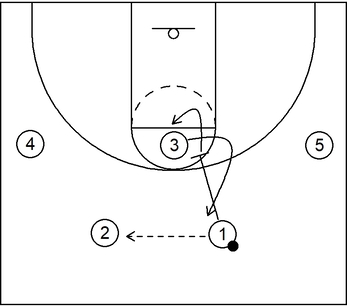
This is an example of delay offense derived from Tempo Control & Delay Sets by Lason Perkins. In terms of the initial set-up, 1 and 2 begin in the slot areas while 4 and 5 are on the wings. Also, 3 starts at the high post area.
It should be noted as well that each player is generally interchangeable so it is possible to swap players around based on need or personnel.
Furthermore, Coach Perkins refers to this particular set as triangle delay because the two offensive players in the slot areas form a triangle with the high post offensive player primarily to implement delay action for a certain amount of time.
The main actions within this delay set includes the down screen, the back screen, and the slip screen.
Additionally, the two slot players will typically pass and screen away or pass and cut to the basket.
To start, 2 receives the ball from 1 and after that, 3 cuts to the right slot area by way of the down screen set by 1. Moreover, 1 fills and replaces at the high post area.
Since this is delay action, the offensive team is not necessarily looking to score against a defense, particularly this quickly.
Part 2
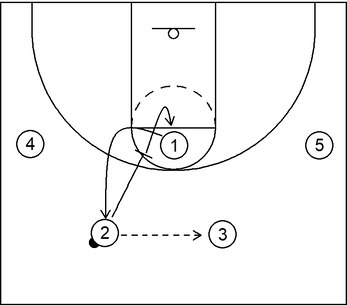
Next, 3 receives the ball from 2 and then 1 cuts to the left slot via the down screen set by 2. Furthermore, 2 fills the high post area.
Again, this is delay action so the offensive team is not necessarily looking to score just yet.
Also, notice that the action that is occurring between the slot players and the high post player is essentially a continuity pattern.
Part 3
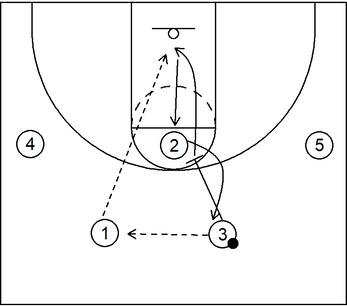
Following the previous action, 1 receives the ball from 3. From that, 2 cuts to the right slot area via the down screen set by 3.
However, this time, 3 slips to the basket as opposed to simply filling the high post area.
Afterwards, 3 could receive the ball from 1, preferably by way of a bounce pass, and then score at the rim via a layup or dunk.
Nevertheless, if 3 is not open to receive the ball, then 3 could quickly fill the high post, similar to what would have occurred without the slip action.
Part 4
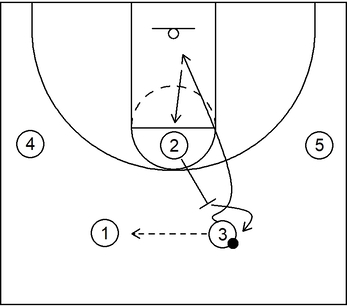
Here is a variation that features a back screen from the high post player instead of a down screen from the slot player.
It should also be mentioned that this back screen option could be very useful if the defender attempts to put a substantial amount of pressure on the slot player that passes the ball.
To start, let’s say that 3 initially has possession of the ball, similar to the previous part. From there, 1 receives the ball from 3 as before.
However, this time, 3 cuts to the basket via a back screen set by 2. In addition to that, 2 fills the right slot following the screening action.
Let’s also say that 3 is not open and therefore, 3 fills and replaces at the high post area.
Part 5
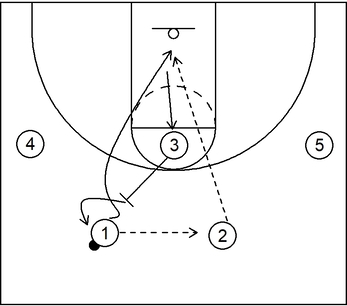
Next, 2 receives the ball from 1 and then 1 cuts to the basket via the back screen set by 3.
After that, 1 could receive the ball again from 2 and score via a layup or dunk at the rim.
Also, 3 would fill the left slot following the screen and if 1 is not open, 1 would fill the high post area.
Part 6
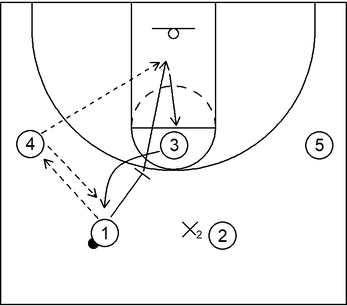
This is a variation of the delay set when denial defense happens near the opposite slot.
For this instance, let’s say that X2 is denying with a hand in the passing lane so that 2 cannot easily receive the ball.
If that occurs, then 4 could receive the ball from 1. Afterwards, 3 could cut to the left slot via the down screen set by 1.
In addition to that, 1 could slip the screen and receive the ball from 4 to ultimately score at the rim.
Nonetheless, if that is not available, then 1 could fill and replace at the high post while 3 receives the ball from 4.
Part 7
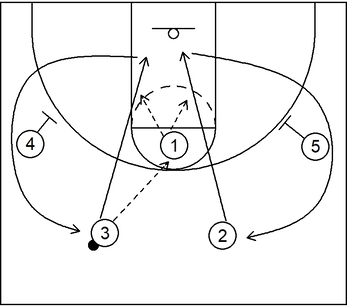
This is a variation of the delay set when the ball is in the high post. It is possible to implement this action when the opposite slot and/or strong side wing get denied but it could be executed without denial defense as well.
To begin, 1 receives the ball in the high post. Next, 3 (who is the passer) immediately follows with a cut to the basket and could receive the ball from 1 if that is open.
Otherwise, 3 could loop back to the left slot (self-replace) via the down screen set by 4 while 2 cuts to the basket.
From that point, 2 could receive the ball from 1 if that is open as well. If the scoring opportunity is not there, then 2 could loop back, similar to 3, by way of the down screen set by 5.
The last option is for 1 to execute high post isolation action and try to score via a jump shot or drive to the basket.
Part 8
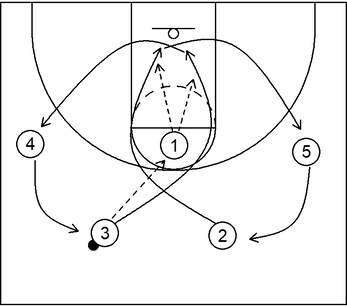
This is a wrinkle of the previous delay set. To start, 1 receives the ball from 3. Immediately after, 3 and 2 utilize the scissors cut and could receive the ball from 1 to score near the rim.
At the same time, 4 and 5 fill at the left and right slot areas respectively. Moreover, if 2 and 3 do not receive the ball from 1, then both of those players fill at the right and left wing areas respectively.
Moreover, once again, 1 could execute high post isolation action in an attempt to score a field goal or generate free throws if the on-ball defender commits a shooting foul.
Part 9
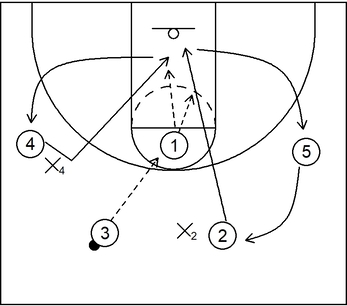
This is yet another wrinkle of the delay set. This time, the action is somewhat reminiscent of the blind pig and/or wing reverse sequences, originally based from the triangle offense.
This is also a great option to consider if both the slot and wing are denied as represented on the diagram. To start, 1 receives the ball from 3.
Following that, 4 executes a quick backdoor cut and could receive the ball from 1, which could result in a scoring opportunity at the rim.
However, if 4 does not receive the ball, then 4 could simply self-replace to the same wing area as before.
Furthermore, if 4 is not able to score, then 2 could try a backdoor cut of their own, possibly receive the ball from 1, and then score at the rim.
Nonetheless, if 2 is not able to score as well, then 5 could fill the right slot while 2 fills the right side wing. Once again, the last scoring option is high post isolation action from 1.